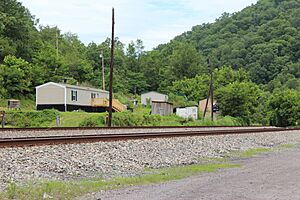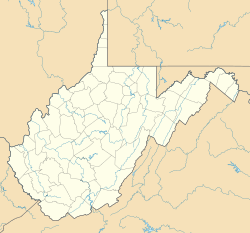Vulcan, West Virginia facts for kids
Quick facts for kids
Vulcan, West Virginia
|
|
|---|---|

Houses along the railroad in Vulcan
|
|
| Country | United States |
| State | West Virginia |
| County | Mingo |
| Elevation | 738 ft (225 m) |
| Time zone | UTC-5 (Eastern (EST)) |
| • Summer (DST) | UTC-4 (EDT) |
| ZIP codes |
25697
|
| Area code(s) | 304 & 681 |
| GNIS feature ID | 1555899 |
Vulcan is a small, unincorporated community in Mingo County, West Virginia, United States. An "unincorporated community" means it's a group of homes and businesses that doesn't have its own official local government like a city or town. Vulcan is located right along the Tug Fork river, which forms part of the border with Kentucky.
The community was named after Vulcan, the god of fire in ancient Roman stories. Vulcan gained international attention in the 1970s when its residents asked for help from the Soviet Union to replace a collapsed bridge. This bridge was the only easy way for people to get in and out of the community.
Vulcan started as a place where people mined coal in the early 1900s. However, by 1968, most of the coal had been dug up. This led to many people moving away from the community.
The Famous Bridge of Vulcan
For a long time, Vulcan didn't have a proper road connecting it to the rest of West Virginia. People relied on a swinging bridge that crossed the Tug Fork river into Kentucky Route 194. This bridge was too narrow for cars and trucks. By the early 1970s, the bridge was in very bad shape, with many wooden boards missing.
Bridge Collapse and Call for Help
Between 1974 and 1975, the old bridge completely fell apart because its wood had rotted away. The local leader of Vulcan tried to get help from both the state and federal governments to build a new bridge, but nothing happened.
So, in 1977, a local leader named John Robinette decided to try something unusual. He asked for foreign aid from the Soviet Union and East Germany to replace the town's bridge. This was a surprising request, especially during the Cold War, when the United States and the Soviet Union were not allies.
Soviet Journalist Visits Vulcan
A Soviet journalist named Iona Andronov visited Vulcan on December 17, 1977. He came to meet with Robinette and see the broken bridge for himself. Interestingly, within just an hour of his visit, reporters were told that the state of West Virginia would finally replace the bridge.
The West Virginia Legislature quickly approved $1.3 million to fund the new bridge. The new bridge was built and officially opened in 1980, solving Vulcan's transportation problem.




